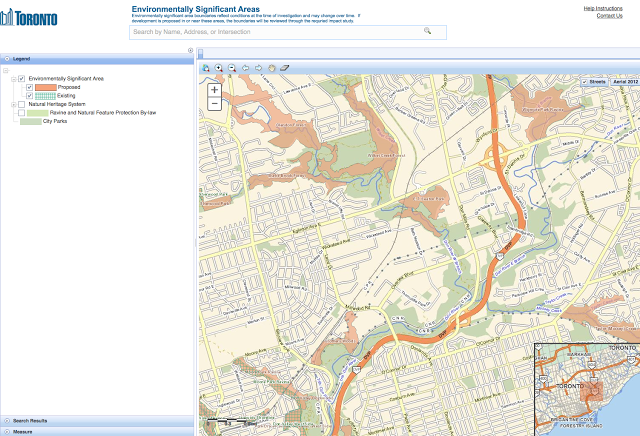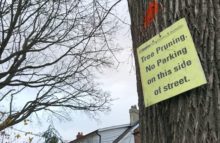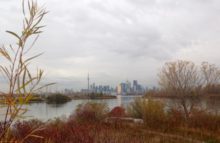| Beautiful Crothers Woods will now be an official environmentally significant area in Toronto. |
Our beautiful ravine systems are one of the best things about Toronto,
counteracting the concrete and condos, right in the very heart of the
city. We are fortunate to have so many stunning, wild areas in Toronto: places where nature does the gardening for us all on its own, creating ultimate no-maintenance (for us) gardens that city dwellers can appreciate every da
y of the year. The good news is that the city is adding 68 new environmentally significant areas—known as ESAs—to its official city plan.You can see the areas in the ESA Interactive Map, pictured below.
 |
| Portion of Toronto’s interactive city map shows new proposed protected areas in orange. |
These are areas that exist already as wild spaces, but will now be protected in black and white, with official city recognition and involvement. Toronto will support these four areas:
- Maintenance
- Invasive species control
- Encroachment
- Overuse
Maintenance:
Natural parklands don’t have lawns to be mowed or fences to be painted
but they still require management to maintain and sometimes restore or
enhance their ecological values.
 |
| Walkers in Crothers Woods, October, Toronto |
Invasive Species:
i.e. Species that “threaten the integrity of many of our natural areas” like the dreaded Dog Strangling Vine we’ve written about, which is threatening to take over huge sections of our wild spaces.
Invasive plants find their way into parklands by wind; flooding; seeding
by wildlife tracking in seeds caught on pets, clothing and shoes; and
the dumping of fill, garden waste and compost. Invasive species cannot
be entirely eliminated from Environmentally Significant Area’s but the
City of Toronto Urban Forestry Services group is currently working to
control some of the established populations of invasive plants in
natural parklands.
Encroachment:
Encroachment by neighbours, dumping, mountain bikes, off-leash dogs, and ad hoc paths can degrade the quality of natural areas.
The City ofonline pharmacy buy bupropion with best prices today in the USAToronto is working to manage the impacts of encroachments
through removal, followed by restoration of natural areas, better
signage and enforcement, and through development of alternative sites
for off-leash dogs and mountain bike skills parks.
Overuse:
To balance access to and the protection of natural areas with
recreational uses in order to maintain their significant qualities. The
City of Toronto is working with mountain bike user groups such as Toronto Off-Road Bicycling Association (TORBA), and International Mountain Biking Association (IMBA) along with Park ‘Friends’ groups to
communicate with park users to educate and seek their support for the
protection of natural areas.





3 comments
Good for the metro Toronto area. Canada has always been a leader in environmental protection so it does not surprise me they will go the extra mile. Invasive species control in our area is daunting as I have done volunteer work in these efforts, so I applaud those of the City of Toronto Urban Forestry Services. I have seen the Niagara Parks Dept. (if that is what you call them in Niagara Falls, ON.) at work on this near me.
Toronto Urban Forestry, along with Toronto Region Conservation Authority, are allowing a huge development in the Guild Woods ESA. Leader in environmental protection? Evidently not.
As far as I can see, with a little online research, the development (and it is large) is on the original Guildwood estate, and not on the Guild Woods ESA which is right beside it. If you find differently, come back and let us know.